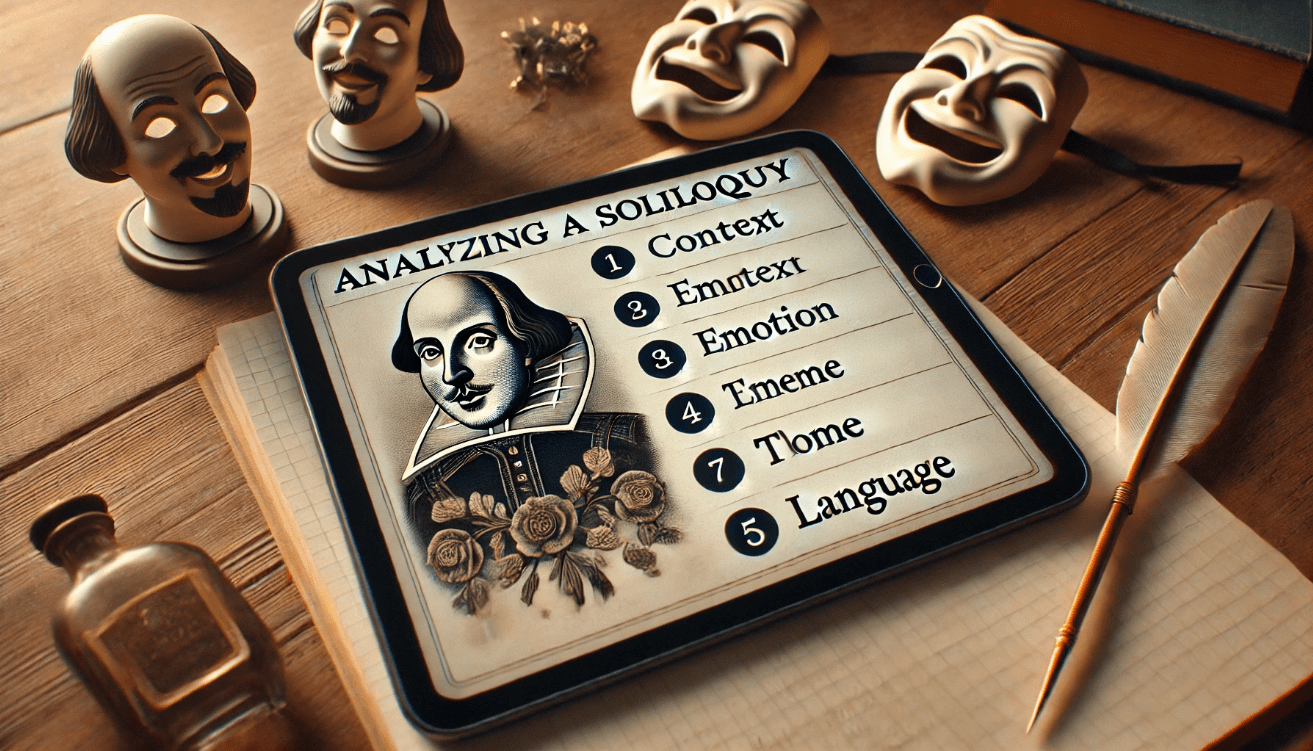
How The Psychological Impact of Soliloquies on Character Portrayal Enhances Literary Analysis
Ever wondered what a character’s private thoughts reveal about their true self? 🤔 Soliloquies, those captivating moments when characters speak their minds alone, unlock the psychological impact of soliloquies on character portrayal, offering a window into their deepest emotions and conflicts. Whether you’re a student struggling with literary analysis or a reader craving richer story connections, this article will show you how soliloquies enhance understanding and empathy. Get ready to discover practical steps to analyze these powerful monologues, making literature more engaging and meaningful. Dive in to transform how you connect with characters! 😊
Table of Contents
ToggleWhat Are Soliloquies and Why Are They Important?
 A soliloquy is when a character speaks their thoughts aloud, alone on stage, revealing their inner world. Think of it as a peek into their mind, like Hamlet pondering life in his famous “To be or not to be” speech. 😊 It’s a dramatic tool that strips away pretense, showing raw emotions and motivations.
A soliloquy is when a character speaks their thoughts aloud, alone on stage, revealing their inner world. Think of it as a peek into their mind, like Hamlet pondering life in his famous “To be or not to be” speech. 😊 It’s a dramatic tool that strips away pretense, showing raw emotions and motivations.
Soliloquies shine in plays like Shakespeare’s Macbeth or modern monologues in films. They’ve been used for centuries to make characters feel real and relatable. By exposing a character’s fears, dreams, or conflicts, soliloquies pull readers into the story’s heart.
Why do they matter? They help you understand complex characters, making stories more gripping. For students, soliloquies are gold for essays, offering clear insights into a character’s psyche. For readers, they create emotional connections, turning flat characters into unforgettable ones.
The Psychological Impact of Soliloquies on Character Portrayal
Soliloquies pull back the curtain on a character’s mind, revealing their deepest thoughts and feelings. This raw glimpse into their psyche creates the psychological impact of soliloquies on character portrayal, making them feel alive and complex. 😊 Let’s explore how this works.
 First, soliloquies expose inner conflicts. Take Hamlet’s “To be or not to be” speech—it wrestles with life, death, and doubt, showing his turmoil. This helps readers understand why characters act the way they do, adding depth to their choices.
First, soliloquies expose inner conflicts. Take Hamlet’s “To be or not to be” speech—it wrestles with life, death, and doubt, showing his turmoil. This helps readers understand why characters act the way they do, adding depth to their choices.
Second, they showcase raw emotions. In Macbeth, the “Is this a dagger” soliloquy reveals guilt and ambition battling inside him. Readers connect with these emotions, making even flawed characters relatable.
Third, soliloquies hint at future actions. A character’s private thoughts often foreshadow their decisions, like Lady Macbeth’s ruthless plans, keeping readers hooked on the story’s direction.
Finally, they build empathy. By hearing a character’s unfiltered thoughts, you see their struggles and motivations, even for villains. This makes stories more engaging and characters unforgettable.
How Soliloquies Enhance Literary Analysis
Soliloquies are a goldmine for literary analysis, offering a direct line to a character’s thoughts and emotions. They make stories richer and help readers uncover deeper meanings. Here’s how soliloquies level up your analysis game! 😊
Unveiling Hidden Themes:
Soliloquies often tie directly to a story’s big ideas. For example, Hamlet’s “To be or not to be” speech explores life and death, helping you connect his personal struggles to universal themes. Look for key phrases to spot these links.
Decoding Subtext:
The words in a soliloquy—metaphors, tone, or repeated ideas—reveal what’s beneath the surface. In Macbeth, the “dagger” soliloquy uses vivid imagery to show guilt. Analyzing these clues helps you understand the character’s mindset.
Comparing Characters:
Soliloquies let you contrast characters’ inner worlds. Compare Hamlet’s doubt-filled speech with Claudius’s guilt-ridden one to highlight their moral differences. This sharpens your insights into the story’s dynamics.
Strengthening Arguments:
For students, soliloquies are perfect evidence for essays or discussions. They provide clear, quotable moments to support your ideas about a character’s motivations or the story’s direction.
Step-by-Step Guide to Analyzing Soliloquies
Unlock the power of soliloquies with this simple, beginner-friendly guide to analyzing them! Whether you’re a student tackling an essay or a reader diving deeper into a story, these steps will help you understand characters like never before. 😊 Let’s break it down.
Step 1: Set the Scene
 Understand the context. What’s happening in the story when the character speaks alone? For example, in Hamlet, the “To be or not to be” soliloquy comes when Hamlet is wrestling with life-or-death decisions. Knowing the situation grounds your analysis.
Understand the context. What’s happening in the story when the character speaks alone? For example, in Hamlet, the “To be or not to be” soliloquy comes when Hamlet is wrestling with life-or-death decisions. Knowing the situation grounds your analysis.
Step 2: Decode the Words
Look for key language clues—metaphors, repetition, or tone shifts. In Macbeth’s “Is this a dagger” speech, the dagger imagery screams guilt. Highlight one or two striking phrases to uncover the character’s mindset.
Step 3: Spot the Emotions
What feelings drive the soliloquy? Fear, anger, or doubt? Hamlet’s speech shows existential dread, while Lady Macbeth’s reveals ruthless ambition. Jot down the main emotion to connect with the character’s heart.
Step 4: Link to Big Ideas
Connect the soliloquy to the story’s themes, like love, power, or morality. Hamlet’s words tie to life’s meaning, enriching your understanding of the play. Ask: How does this speech reflect the story’s core message?
Step 5: Match Words to Actions
Does the soliloquy align with the character’s behavior? Hamlet’s indecision in his speech mirrors his hesitation to act. Comparing words to actions reveals if the character is honest or conflicted.
Common Mistakes to Avoid When Analyzing Soliloquies
Analyzing soliloquies can be tricky, but avoiding these common pitfalls will make your insights sharper and your literary analysis stronger. Whether you’re a student or a curious reader, steering clear of these mistakes will help you unlock the full power of a character’s inner thoughts. 😊 Let’s dive in!
Mistake 1: Ignoring the Story’s Context
Reading a soliloquy out of context can lead to confusion. For example, Hamlet’s “To be or not to be” speech makes sense only when you know he’s grappling with revenge and mortality. Always check what’s happening in the story first.
Mistake 2: Just Summarizing the Plot
Retelling what the character says misses the psychological depth. Instead of summarizing Macbeth’s “Is this a dagger” speech, focus on how it reveals his guilt and ambition. Dig into emotions, not just events.
Mistake 3: Skipping Language Details
Overlooking metaphors or imagery weakens your analysis. In Lady Macbeth’s soliloquy, her call to “unsex” herself shows her rejection of femininity. Highlight key phrases to uncover hidden meanings.
Mistake 4: Not Connecting to Themes
Failing to tie the soliloquy to bigger ideas limits insight. Hamlet’s speech isn’t just about doubt—it connects to the play’s theme of existential struggle. Always ask: How does this reflect the story’s core message?
Real-Life Applications: Why This Matters Beyond Literature
 Soliloquies aren’t just for dusty old plays—they offer skills that make life richer and more connected! Understanding their psychological depth can help you in school, relationships, and even your own creative projects. Here’s why analyzing soliloquies matters in the real world. 😊
Soliloquies aren’t just for dusty old plays—they offer skills that make life richer and more connected! Understanding their psychological depth can help you in school, relationships, and even your own creative projects. Here’s why analyzing soliloquies matters in the real world. 😊
Sharpen Critical Thinking:
Breaking down a soliloquy, like Hamlet’s wrestle with life and death, trains you to analyze complex emotions and motivations. This skill helps you solve problems at work or school by seeing beyond surface-level actions.
Build Empathy:
Soliloquies reveal characters’ struggles, like Macbeth’s guilt. Applying this lens to real people helps you understand their feelings and perspectives, strengthening friendships and teamwork. Who knew Shakespeare could improve your relationships? 😄
Boost Academic Success:
For students, mastering soliloquy analysis can lead to better essays and higher grades. Use insights from Juliet’s romantic musings to nail that literature exam or class discussion.
Inspire Creative Writing:
Writers can borrow soliloquy techniques to craft vivid, relatable characters. Try writing a character’s inner monologue to make your stories pop with depth and emotion.
Case Studies: Iconic Soliloquies and Their Impact
Soliloquies bring characters to life, and these iconic examples show how they shape stories and captivate readers. Let’s explore three famous soliloquies, their psychological depth, and why they matter. These case studies will help you see how to apply analysis to any story! 😊
Hamlet’s “To be or not to be” (Hamlet, Shakespeare)

- Psychological Insight: Hamlet questions life, death, and action, revealing his deep existential doubt and indecision.
- Impact on Portrayal: This speech paints Hamlet as a thoughtful, conflicted hero, making readers empathize with his struggle.
- Why It Matters: It connects to themes of mortality, hooking readers into the play’s big questions.
Macbeth’s “Tomorrow and tomorrow” (Macbeth, Shakespeare)
- Psychological Insight: Macbeth reflects on life’s futility after loss, showing despair and nihilism.
- Impact on Portrayal: It transforms him from an ambitious villain to a broken man, adding tragic depth.
- Why It Matters: Readers see the cost of ambition, making his downfall emotionally gripping.
Modern Example: Kendall Roy’s Monologue (Succession, Season 3)
- Psychological Insight: Kendall’s raw confession about his guilt and ambition mirrors a soliloquy’s intimacy.
- Impact on Portrayal: It reveals his inner turmoil, making a flawed character relatable.
- Why It Matters: Shows how soliloquy-like moments in modern media deepen character-driven stories.
 Soliloquies are more than just dramatic speeches—they’re windows into a character’s soul, making stories unforgettable. By revealing inner thoughts and emotions, they deepen your connection to characters and sharpen your literary analysis skills. 😊 Whether you’re a student aiming for better grades or a reader craving richer stories, understanding soliloquies unlocks new insights. Try analyzing one, like Hamlet’s or even a modern monologue, to see the magic for yourself. Grab a play or show, apply the steps from this guide, and share your discoveries with friends or a book club. Start exploring today! 📚
Soliloquies are more than just dramatic speeches—they’re windows into a character’s soul, making stories unforgettable. By revealing inner thoughts and emotions, they deepen your connection to characters and sharpen your literary analysis skills. 😊 Whether you’re a student aiming for better grades or a reader craving richer stories, understanding soliloquies unlocks new insights. Try analyzing one, like Hamlet’s or even a modern monologue, to see the magic for yourself. Grab a play or show, apply the steps from this guide, and share your discoveries with friends or a book club. Start exploring today! 📚
Frequently Asked Questions (FAQs)
1. What is the purpose of soliloquies in literature?
Soliloquies reveal a character’s private thoughts and emotions directly to the audience. They help uncover inner conflicts, motivations, and desires that aren’t shown in dialogue with others.
2. How do soliloquies enhance a reader’s understanding of a character?
Soliloquies provide deep insight into a character’s psyche, showing their fears, doubts, or moral struggles. This helps readers understand why characters act the way they do.
3. Why are soliloquies important for psychological analysis in literature?
Soliloquies expose the internal thought processes of characters, making them ideal for exploring psychological themes like identity, guilt, ambition, or madness. They allow readers to analyze mental states beyond surface actions.
4. How can soliloquies improve literary analysis essays?
Including soliloquies in analysis strengthens arguments about a character’s development, internal conflict, or emotional depth. They serve as strong textual evidence to support deeper interpretation.
5. Which literary devices are often used in soliloquies to show psychology?
Writers use metaphor, imagery, repetition, and rhetorical questions in soliloquies to reflect emotional intensity and mental states. These devices help express complex psychological themes more vividly.
6. Can soliloquies change how we view a character’s morality?
Yes, soliloquies often reveal moral struggles or hidden intentions, which can shift how readers judge a character. A villain may seem more human, or a hero more conflicted.
7. What are some famous examples of soliloquies with strong psychological impact?
Hamlet’s “To be or not to be” and Macbeth’s “Is this a dagger which I see before me” are powerful soliloquies that reveal intense inner conflict and mental unraveling. These help readers explore themes like existentialism and guilt.
8. How do soliloquies help readers connect emotionally with characters?
By hearing a character’s inner voice, readers feel closer to their struggles and experiences. This emotional connection makes the story more impactful and memorable.
